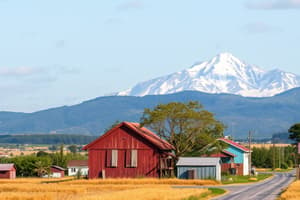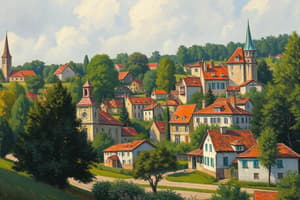Podcast
Questions and Answers
What are pull factors in migration?
What are pull factors in migration?
- Lack of job opportunities
- Famine
- Promise of work (correct)
- Poor educational facilities
Which of the following is NOT a likely push factor for migrants?
Which of the following is NOT a likely push factor for migrants?
- Famine
- War
- Poor medical attention
- Political stability (correct)
What is a common reason for rural migrants to move to urban areas?
What is a common reason for rural migrants to move to urban areas?
- Access to formal housing
- Insufficient agricultural space
- Lack of access to hospitals
- Desire to experience city life (correct)
What can be a consequence of a high number of migrants in cities?
What can be a consequence of a high number of migrants in cities?
Which of the following best defines formal housing?
Which of the following best defines formal housing?
What is one major benefit of urban education institutions for businesses?
What is one major benefit of urban education institutions for businesses?
What is an environmental impact associated with cities?
What is an environmental impact associated with cities?
What factor is NOT a characteristic of a city?
What factor is NOT a characteristic of a city?
Which of the following statements accurately describes informal housing?
Which of the following statements accurately describes informal housing?
Which of the following describes rural-urban migration?
Which of the following describes rural-urban migration?
What is one of the environmental challenges associated with growing cities?
What is one of the environmental challenges associated with growing cities?
Which of the following best exemplifies a function of a city?
Which of the following best exemplifies a function of a city?
Which aspect is vital for the sustainable management of cities?
Which aspect is vital for the sustainable management of cities?
Which of the following is a potential benefit of technological innovations in cities?
Which of the following is a potential benefit of technological innovations in cities?
What is a common misconception about urban areas?
What is a common misconception about urban areas?
Which is NOT a consideration when improving the quality of life in cities?
Which is NOT a consideration when improving the quality of life in cities?
Flashcards are hidden until you start studying
Study Notes
Characteristics of Cities
- Cities have a large population size, varying according to country-specific thresholds.
- High population density is defined as the number of people per square kilometer.
- Cities consist of a built-up area, marked by substantial infrastructure for services like water and electricity.
- A city offers a wide range of functions including administrative, commercial, and economic roles.
Relationship Between Cities and Rural Areas
- Rural-urban migration occurs due to both push and pull factors.
- Push factors include lack of job opportunities, poor educational facilities, medical issues, famine, and war.
- Pull factors involve better job prospects, superior schooling, more healthcare access, vibrant city life, and political stability.
- Cities often depend on rural areas for goods and services, particularly food, due to limited agricultural space.
Impact of Cities on the Environment and Inhabitants
- Cities provide opportunities for education and employment.
- They host various educational institutions that develop a skilled workforce, which businesses can tap into.
- Urban areas foster technological innovations, reducing carbon emissions and enhancing mobility through new products and services.
- Challenges of urban growth include:
- Increased environmental pollution affecting air and water quality.
- Competition for natural resources, including land and water.
Sustainable Management of Cities
- Effective environmental management efforts include:
- Reducing water and air pollution through improved practices.
- Implementing land-use planning and employing high-quality building materials for construction.
- Enhancing quality of life involves:
- Ensuring safe housing options.
- Providing diverse transportation methods.
- Addressing the needs of various demographic groups, including the elderly and disabled.
Types of Housing in Cities
- Formal housing characteristics:
- Constructed by governments or private developers.
- Occupants hold legal rights to the land.
- Access to essential services and built with high-quality materials.
- Informal housing features:
- Self-constructed, often occurring in squatter settlements.
- May lack legal land rights and adequate services.
Studying That Suits You
Use AI to generate personalized quizzes and flashcards to suit your learning preferences.




